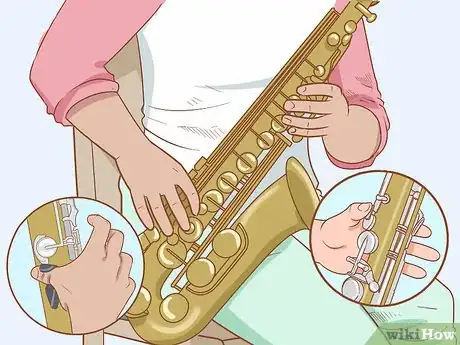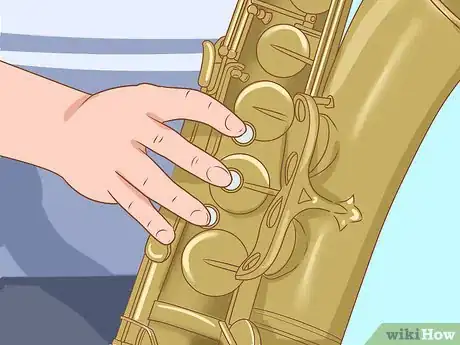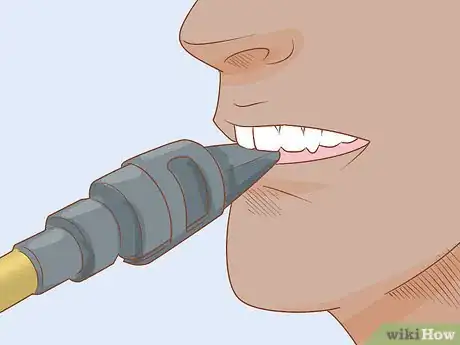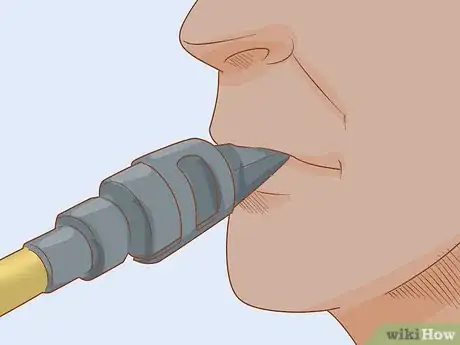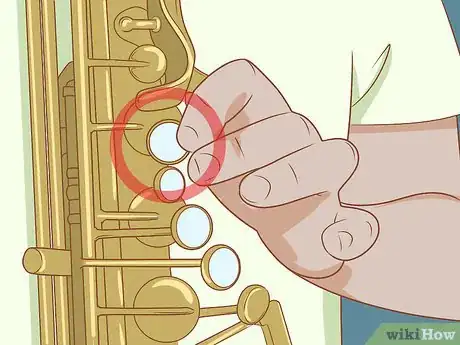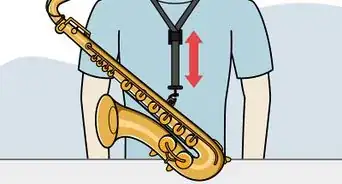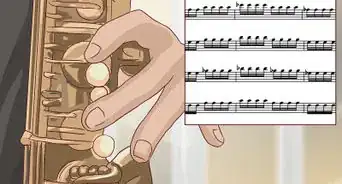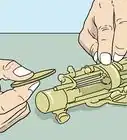This article was co-authored by wikiHow Staff. Our trained team of editors and researchers validate articles for accuracy and comprehensiveness. wikiHow's Content Management Team carefully monitors the work from our editorial staff to ensure that each article is backed by trusted research and meets our high quality standards.
There are 9 references cited in this article, which can be found at the bottom of the page.
This article has been viewed 40,274 times.
Learn more...
Now that you have your saxophone, it's time to play your first note. With your saxophone and mouthpiece fully assembled and ready to go, it can be tempting to just blow into the mouthpiece right away to get your first note. However, blowing into a saxophone and producing a note is slightly more complicated than that. It means holding your saxophone correctly, placing your fingers in the correct positions, and adjusting your mouth to produce a beautiful note.
Steps
Holding the Saxophone Properly
-
1Sit up straight with your saxophone to the right of your body. Keep your back straight and your chin level. With your thumbs in position, keep the mouthpiece of the saxophone towards the center of your body, with the end of the saxophone leaning against your right leg.
-
2Place your two thumbs on their respective thumb-guards. The back of a saxophone will usually have two black pieces of plastic, one near the bottom of the saxophone and one near the top. Grip the lower thumb-guard with your right thumb so that the rest of your fingers can curl around the front. Then, grip the upper thumb-guard with your left thumb so that your fingers can bend around to the front too.[1]
- Your fingers should have plenty of mobility and your thumbs should be able to lift the majority of the weight of the saxophone.
Advertisement -
3Place your left hand over the 3 pearlescent keys. Curl your left fingers around to the front of the saxophone. They should naturally come to rest over four pearlescent buttons, three big and one small. Place your index finger over the top button. Skip the small button and place your middle finger on the middle button. Then place your fourth finger on the bottom button.[2]
- Your pinkie finger will be hovering over a few other keys, but for the time being you don't need to worry about them.
-
4Press the 3 keys at the bottom of the saxophone with your right hand. Once more, curl your right fingers around to the front of the saxophone. There will be three prominent buttons that will naturally come towards your fingers if you have your thumb in the right place. Place your index finger on the top key, your middle finger on the middle key, and your fourth finger on the bottom key.[3]
- Your pinkie will naturally fall onto several other keys, but you needn't worry about them yet.
Blowing into the Mouthpiece
-
1Bring the saxophone to your mouth. With your hands in the correct position, bring the saxophone mouthpiece up to your mouth. Do not move your head in this process. Your hands should be able to do all the work.
- Keep the bottom end of the saxophone tilted to your right-hand side, to make it easier for your right hand to play the lower keys.
-
2Put your two front top teeth on top of the mouthpiece. You're now ready to play your first note. Gently place your two front top teeth about a third of the way down the mouthpiece and let your bottom lip touch the reed underneath.[4]
- This may feel uncomfortable to start with, but the more you practice the more comfortable you will become.
-
3Purse your lips using the muscles around the side of your mouth. With your mouth around the mouthpiece, tighten your lips using the side muscles to secure it in place. You will have created a natural air seal with the only gap being where you have the mouthpiece in your mouth, meaning you have maximum control over the instrument.[5]
- Pretend like you've eaten a piece of sour candy or that you've taken a bite out of a lemon, then purse your lips. The mouth position is remarkably similar.
-
4Press the B key on the saxophone. Playing the B key is the best note to start with on a saxophone because it is the easiest to play. Blowing into the saxophone without playing a note will either sound shrill or not produce a sound at all. With your left hand over the appropriate keys, press the B key with your index finger. The B key is the top key that your index finger will naturally curl towards.[6]
- This will shorten the length the air has to travel when going through the saxophone, resulting in a different note.
- Don't press down too hard on the key. It will be too cumbersome to do so repeatedly and it could damage your saxophone. Press down just hard enough so that the valve underneath the key closes over. You can see it close over yourself beneath the key you're pressing.
-
5Blow through the mouthpiece to play a note. With your mouth in position and your finger pressing down the B key, gently blow into the mouthpiece. The air will travel through the reed, down through the saxophone and out the other end, producing a B note.[7]
- If it doesn't work, try varying the force with which you were blowing. Many beginner saxophone players blow too hard. Imagine you are just exhaling and try blowing through it again.
- Remember, practice makes perfect.
Adjusting Breathing and Mouth Positioning
-
1Visualize the breathing process by performing basic exercises. Breathing exercises will help your technique in general, but it will also expand your lungs with air before you play.
- Start with a simple exercise. Lie on the ground and breathe deeply in and out. Then, place a heavy object on your chest such as a pile of books. Breathe in and out again. The books should move upwards when you breathe in, and downwards when you breathe out. This helps you visualise the breathing process.
-
2Try hissing into the saxophone. The position of your tongue and the shape of your mouth can change the quality of a note. Without the saxophone, take a deep breath in, then hiss for as long as you can. You should let out a long steady stream of air. Now, try the exercise again but into the saxophone mouthpiece.[8]
- Listen closely to the sound of the note. It should sound stronger and more even. Practice this several times until the note sounds identical for 5-10 seconds.
-
3Practice smiling while playing. Although this may sound like a way to look better on stage, it also changes the tonality of your note. By smiling, you are forcing the sides of your mouth towards the mouthpiece. This changes the shape of your mouth, adjusting the sound of the note through your face muscles alone.[9]
- Practice playing a B without smiling, then playing a B with smiling. Listen for the subtle difference in tonality between both notes.
-
4Begin practicing circular breathing. Circular breathing is an advanced technique where you can continue to take air into your lungs while still playing a note. To practice this, fill your mouth with as much water as you can. Then, breathe in and out through your nose several times. Without stopping breathing, purse your lips and try to squirt the water out of your mouth in a steady thin stream. This is the basic concept of circular breathing.[10]
- Once you've mastered circular breathing with water, practice with a saxophone. Puff out your cheeks and blow a B note. Then, bring the back of your tongue to the top of your mouth to seal the mouth from the throat. Then, inhale through your nose, still playing the same B. Then, refill your mouth with the new air by lowering your tongue again.
- This process takes practice, but it's an invaluable skill to learn so that long notes become easy to play.
References
- ↑ https://youtu.be/Be2yAHA9kjo?t=113
- ↑ https://youtu.be/zCQHnZ1cVwU?t=468
- ↑ https://youtu.be/zCQHnZ1cVwU?t=496
- ↑ https://youtu.be/zCQHnZ1cVwU?t=798
- ↑ https://youtu.be/zCQHnZ1cVwU?t=814
- ↑ https://youtu.be/zCQHnZ1cVwU?t=779
- ↑ https://youtu.be/zCQHnZ1cVwU?t=875
- ↑ https://www.thetutorpages.com/tutor-article/saxophone/how-to-blow-the-saxophone-for-beginners/2164
- ↑ https://www.thetutorpages.com/tutor-article/saxophone/how-to-blow-the-saxophone-for-beginners/2164

